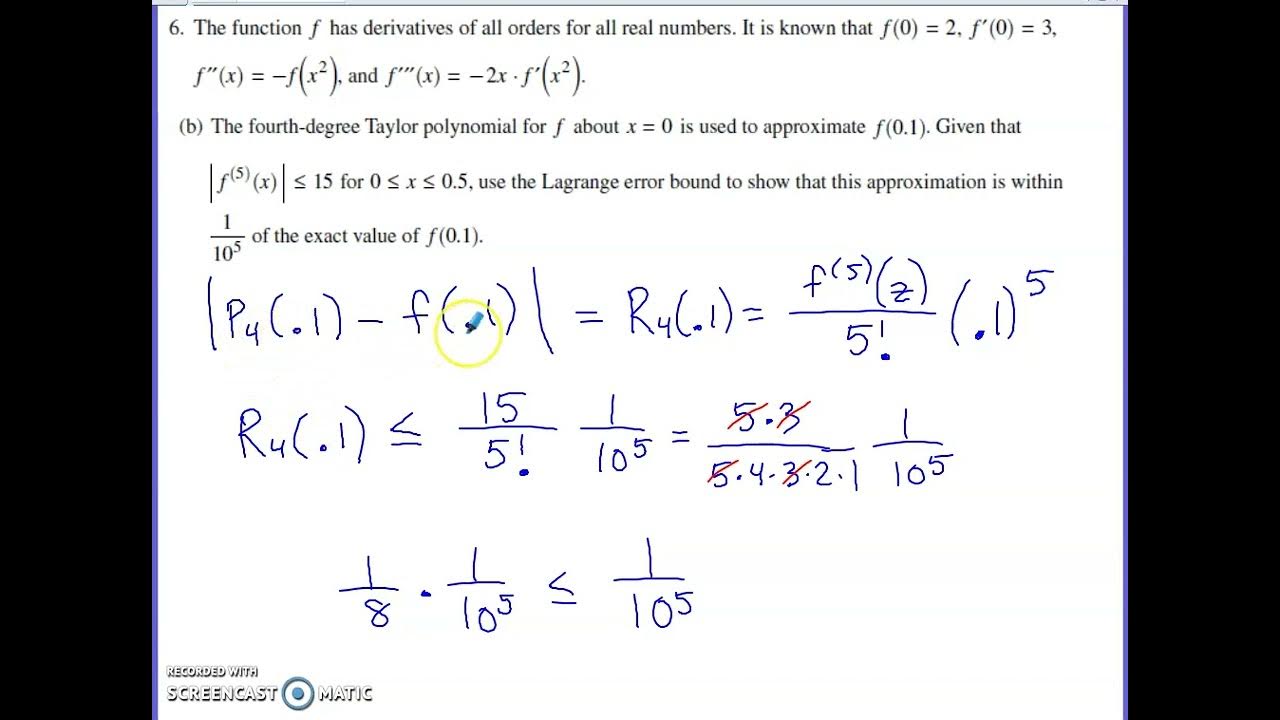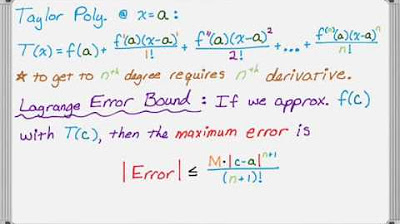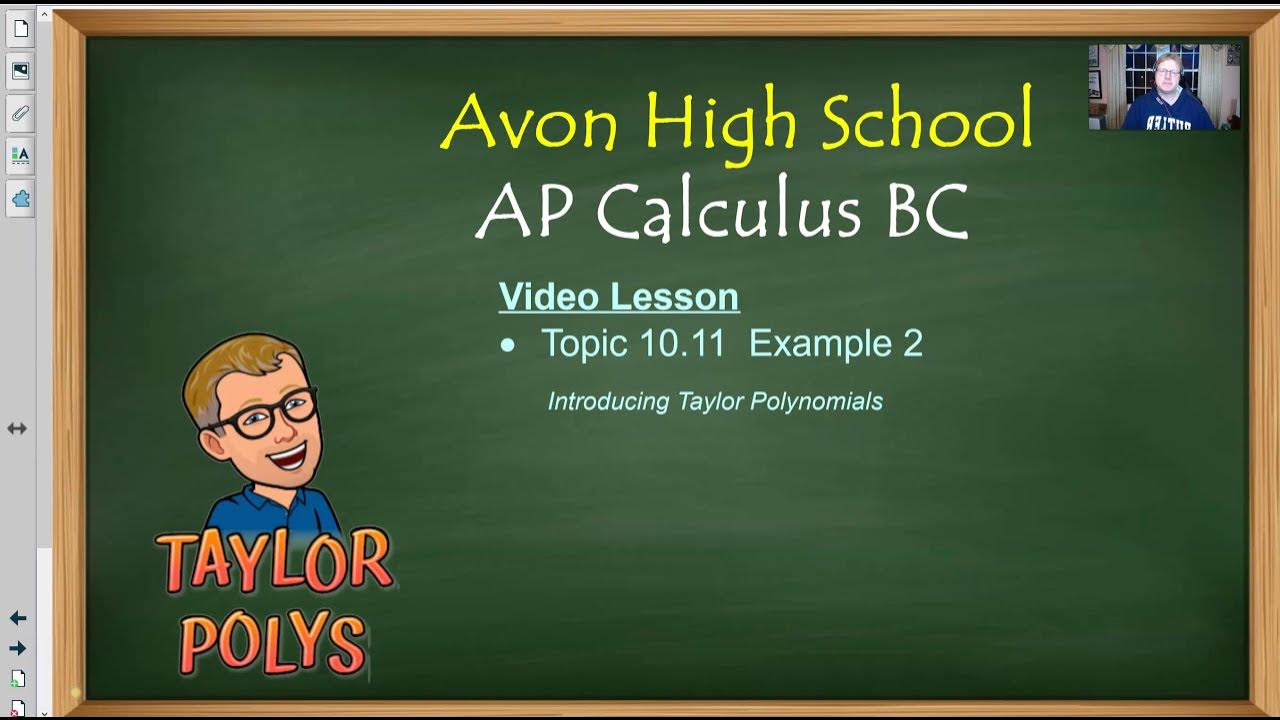Avon High School - AP Calculus BC - Topic 10.12 - Example 3
TLDRIn this educational video, the presenter delves into the complexities of the Lagrange error bound in AP Calculus BC, focusing on approximating the natural logarithm of 1.2 using a Taylor polynomial. The video guides students through the process of determining the degree of the polynomial needed to achieve an approximation error less than 0.001. By leveraging the Taylor series and derivatives, the presenter illustrates the pattern in the natural log's derivatives and applies Taylor's inequality to find the minimum polynomial degree required for the desired accuracy. The video concludes with a practical demonstration of using a third-degree polynomial to approximate the natural log of 1.2 and emphasizes the importance of mastering these concepts for AP Calculus BC exam success.
Takeaways
- 📚 The video discusses the application of Taylor polynomials and the Lagrange error bound in approximating the natural logarithm function.
- 🎯 The goal is to determine the degree of the Taylor polynomial needed to approximate ln(1.2) with an error less than 0.001.
- 📈 The Taylor polynomial for ln(x) is derived up to the fifth term, revealing a pattern in the derivatives and their relation to factorials.
- 🔢 The nth derivative of ln(x) is expressed as (-1)^(n-1) * (n-1)! / x^n, with alternating signs and factorial numerators.
- 📊 Taylor's inequality is used to estimate the error, expressed as a function of the maximum of the (n+1)th derivative of the function within the interval [c, x].
- 🧠 The maximum value of the (n+1)th derivative is determined to be n!, which occurs at the left end of the interval [c, x] for a decreasing function.
- 🔍 The video demonstrates solving for n by setting up an inequality to find the number of terms needed in the polynomial to meet the error requirement.
- 📌 It is concluded that a third-degree polynomial is sufficient to approximate ln(1.2) with an error less than 0.001, as confirmed by a calculator.
- 💡 The importance of mastering Taylor polynomials and the Lagrange error bound for AP Calculus BC students is emphasized to avoid losing points in the exam.
- 🚀 The video encourages students to utilize additional resources and practice materials to improve their understanding of the topic.
- 📅 The next video will cover intervals and radius of convergence for power series, which are also important concepts in AP Calculus BC.
Q & A
What is the main topic of the video?
-The main topic of the video is the Lagrange Error Bound and its application in approximating the natural logarithm function using Taylor polynomials.
What is the specific problem the video aims to solve?
-The video aims to solve the problem of determining the degree of the Taylor polynomial, p_n(x), that should be used to approximate the natural log of 1.2 such that the error is less than 0.001.
How does the video introduce the Taylor polynomial for the natural log function?
-The video introduces the Taylor polynomial for the natural log function by listing the first few terms from a table and then encouraging the viewer to recognize the pattern to find the general form of the polynomial.
What is Taylor's Inequality and how is it used in this context?
-Taylor's Inequality states that the absolute value of the error (R_n) is less than or equal to the absolute value of the maximum of the (n+1)th derivative of the function, f, evaluated at some point c (where z lies between c and x), divided by (n+1)! times (x-c)^(n+1). It is used to estimate the error in the approximation of a function by a Taylor polynomial.
How does the video determine the pattern for the derivatives of the natural log function?
-The video determines the pattern by computing several derivatives of the natural log function and observing that the numerators are alternating factorial values and the denominators are powers of x, leading to the general formula for the nth derivative.
What is the significance of the factorial values in the numerator of the nth derivative?
-The factorial values in the numerator indicate the alternating pattern of the derivatives. Each term is a fraction with a numerator that is a factorial value and an alternating sign, which helps in deriving the general formula for the Taylor polynomial of the natural log function.
How does the video solve for the degree of the Taylor polynomial needed to approximate the natural log of 1.2 within the desired error?
-The video uses the formula derived from Taylor's Inequality and plugs in the values for x, c, and the error limit. By trial and error, it finds that n must be equal to 3 to ensure the error is less than 0.001.
What is the final degree of the Taylor polynomial needed for the approximation?
-The final degree of the Taylor polynomial needed for the approximation is 3, as determined by the trial and error method in the video.
How does the video verify the approximation?
-The video verifies the approximation by calculating the value of the third-degree Taylor polynomial at x=1.2 and comparing it to the actual value of the natural log of 1.2, ensuring the difference is less than 0.001.
What is the importance of mastering the Lagrange Error Bound in AP Calculus BC?
-Mastering the Lagrange Error Bound is important in AP Calculus BC as it helps students to accurately approximate functions using Taylor polynomials, which can be crucial for not conceding points in the exam.
What are the next topics the video series will cover?
-The next topics the video series will cover are intervals and radius of convergence for power series, as mentioned in the video.
Outlines
📚 Introduction to Lagrange Error Bound and Taylor Polynomial
The video begins with a welcome back to students and introduces the topic of the Lagrange error bound and Taylor polynomial. The speaker commends the viewers for their efforts in understanding the previous examples and encourages them to continue learning about the components of this complex problem. The goal is to determine the degree of the Taylor polynomial that approximates the natural log of 1.2 with an error less than 0.001. The speaker suggests using a green table from a previous topic to find the Taylor polynomial for the natural log of x and emphasizes the importance of understanding the series aspect of the problem.
🔢 Derivatives and Pattern Recognition for Natural Log Function
The speaker delves into the challenge of computing the derivatives of the natural log function to find a pattern. The first few derivatives are calculated, revealing an alternating sign pattern and the numerators being factorial values. The speaker hypothesizes a formula for the nth derivative of the function, which involves n! (factorial of n) and an alternating sign. The goal is to use these derivatives to apply Taylor's inequality and estimate the error in approximating the natural log of 1.2.
📈 Applying Taylor's Inequality to Determine Polynomial Degree
The speaker explains the application of Taylor's inequality to find the maximum error and determine the degree of the Taylor polynomial needed for the approximation. The process involves evaluating the nth plus one derivative at a point 'z' between 'c' and 'x' (1 and 1.2, respectively), and using the factorial of 'n' to estimate the maximum value of the derivative. The speaker then sets up an inequality to solve for the degree of the polynomial that will satisfy the error condition of less than 0.001.
🎓 Solving for Polynomial Degree and Verifying the Approximation
The speaker guides the viewers through solving the inequality derived from Taylor's error bound to find the minimum degree of the Taylor polynomial required for the approximation. Through trial and error, it is determined that a third-degree polynomial is sufficient to meet the error criteria. The speaker then verifies this by calculating the approximation using the third-degree polynomial and comparing it to the actual value of the natural log of 1.2, confirming that the difference is indeed less than 0.001. The video concludes with a reminder of the importance of mastering these concepts for the AP Calc BC exam.
Mindmap
Keywords
💡Taylor Polynomial
💡Lagrange Error Bound
💡Derivatives
💡Natural Logarithm
💡Taylor's Inequality
💡Approximation
💡Factorials
💡Polynomial Degree
💡Error Analysis
💡Series
Highlights
The discussion focuses on understanding the components of the Lagrange error bound in the context of approximating the natural logarithm function.
The goal is to determine the degree of the Taylor polynomial needed to approximate ln(1.2) within an error of less than 0.001.
The Taylor polynomial for the natural log of x is derived and simplified using a pattern recognition approach.
The Taylor series for ln(x) is shown to be equivalent to x - 1 - (x - 1)^2/2 + (x - 1)^3/3 - ...
Taylor's inequality is introduced as a method to estimate the error in polynomial approximations.
The nth derivative of ln(x) is found to follow a pattern of alternating signs and factorial values in the numerator.
The nth derivative formula for ln(x) is deduced as (-1)^(n-1) * n! / x^n
The maximum value of the nth derivative is determined to be n! when evaluated at x = 1.
An inequality is set up to find the minimum degree of the polynomial that satisfies the error bound of 0.001.
Through trial and error, it is determined that a third-degree polynomial is sufficient for the approximation.
The approximation of ln(1.2) using the third-degree polynomial is verified to be within the desired error bound.
The importance of mastering the Lagrange error estimate for AP Calculus BC exam success is emphasized.
The video encourages students to seek out additional resources and practice materials to improve their understanding of the topic.
The next video will cover intervals and radius of convergence for power series, expanding on the concepts introduced.
The video concludes with a call to action for viewers to subscribe for future content.
Transcripts
Browse More Related Video

2023 AP Calculus BC FRQ #6

2023 AP Calculus BC Free Response Question #6

The Lagrange Error Bound for Taylor Polynomials

Avon High School - AP Calculus BC - Topic 10.12 - Example 2

Worked example: estimating sin(0.4) using Lagrange error bound | AP Calculus BC | Khan Academy

Avon High School - AP Calculus BC - Topic 10.11 - Example 2
5.0 / 5 (0 votes)
Thanks for rating: